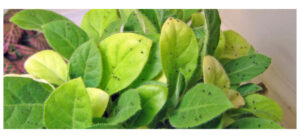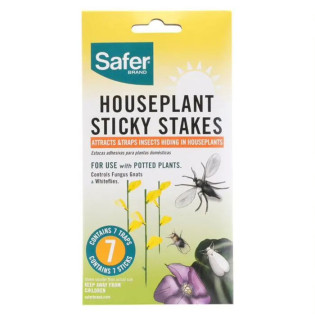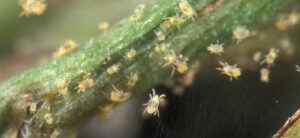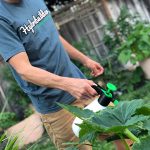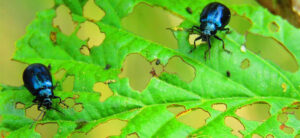
Fungus gnats are a common indoor grow room pest, and can be incredibly frustrating.
These small, black, mosquito-like flies reproduce rapidly and endlessly. If you do not take swift action at the first sign of an infestation, you are in for a world of trouble.
Regardless of whether you are growing indoors or outdoors, you can run into these pesky bugs.
Luckily, treating your infested grow room or garden can be pretty simple. We will give you a number of ways to eradicate them, ranging from standard pesticides to beneficial bugs.
First, though, we need to go into more detail into what these bugs actually look like, and how to identify them. There are also a few things you need to know to ensure you aren't inviting them into your garden.
What are fungus gnats?

As briefly mentioned above, fungus gnats are tiny black flies, and appear mosquito-like sometimes.
They are also commonly confused as fruit flies, but using a microscope, they can be easily differentiated.
The fungus gnat life cycle
This common indoor and outdoor garden pest has an endless life cycle. Adults will lay their eggs in your soil, and these eggs hatch into larvae.
The larvae will then feed on your root hairs. This causes serious damage to your plant.
The larvae will grow into a maggot after a few days, and cocoon itself. It then hatches into an adult fungus gnat, and the life cycle repeats.
What do fungus gnats do to plants?
We just touched on it a bit, but fungus gnats do their damage in the soil and beneath.
The larvae feeds on delicate roots, and causes irreversible damage in some cases.
This damage results in stunted plant growth and yellowing of leaves due to an inability to uptake nutrients and water.
As this process runs it course, the plant will slowly die unless corrective measures are taken.
Let's talk about why you may be battling these gnats in the first place.
What causes fungus gnats in the garden or grow room?

There are a number of reasons you may be seeing these guys buzzing around your plants or crawling in your soil.
A lot of it comes down to human error, but there are certain cases where they can be brought in on new plants, or on humans/animals.
Over watering your plants
One of the most common reasons you are battling fungus gnats is probably from giving your plants more water than they need. New growers are notorious for feeding plants more than they need.
This will lead to water-logging, and create a perfect environment for fungus gnats. Warm, wet soil is a sanctuary for fungus gnats to start laying eggs. Once the eggs are present, you are in for trouble.
Check out our guide on how to properly water your plants if you're a new grower, as this will help you prevent overwatering.
High concentration of CO2 in the grow room
Serious growers will introduce CO2 into their grow room or grow tent to supercharge plant growth. This is a great way to maximize your yield and decrease your time till harvest, while increasing the potency of your buds.
But the very same tactics used to get the most out of your grow can actually have detrimental affects.
High levels of carbon dioxide will attract fungus gnats, and if they already exist in your grow, it will only make them happier.
If you are dealing with fungus gnats, its a good idea to turn off your CO2 producers until its under control. We recommend you check out our guide on using grow room CO2 properly if you are hoping to try it out.
What kind of soil are you using?
There are certain soils that are more conducive to fungus gnat infestations than others. While these soils have plenty of benefits, they can also be the reason you have an infestation.
If you are using soilless mixes including peat, coco, or compost, you should be extra wary of fungus gnats.
You can learn more about the different types of soils you can use to grow with here.
Poor ventilation is a welcome mat for fungus gnats
Your atmosphere and ventilation system are crucial to preventing pests like fungus gnats from entering your grow room. If your environment is not on point, you are asking for problems.
A few things you need to be aware of is temperature, humidity, and air circulation. These can be kept under control with a ventilation system.
Stagnant air can cause lots of problems, one of which is pests and diseases. That is why it is important to circulate air with a grow room fan.
You can check out our complete guide on grow room environment here to determine if your atmosphere is actually dialed in.
A ventilation system is essential for bringing in fresh, clean air and expelling hot, stinky air.
If your system is not properly sealed, however, it can actually be counterproductive, bringing bugs and harmful contaminants in through your intake or exhaust ducting.
You can prevent this by sealing your system with a HEPA intake filter. This is a high quality particulate filter, and will stop bugs and contaminants in their tracks. Check out our tips on setting up your ventilation system.
How do you get rid of a fungus gnat infestation?

If you take these precautionary steps to prevent fungus gnats from finding your plants, you will seriously reduce your chances of encountering them.
However, even the best grow rooms can still fall victim to any common indoor gardening pest.
Here are a few different ways you can treat an infestation.
Sticky yellow fly traps
Your first line of defense should be sticky flip traps, preferably yellow in color. Don't ask why, but fungus gnats are attracted to the color yellow.
If you hang a few of these around your plants, they will get caught.
This will slow down your infestation and stop it from spreading, but it isn't going to do the job all on its own.
You should have these in your grow room even before you spot an infestation, as they will alert you that one is starting.
Insecticides for fungus gnats
The most sure fire way to eradicate these pests is with insecticides or pesticides.
There are a variety you can use, and we even carry some of these here at Hydrobuilder. Our year end review of the top insecticides & fungicides will help you choose the right one, but, here are a few of our favorites:
Neem oil
Neem oil is a natural insecticide, and can be used to treat a number of infestations. It can be applied as a foliar spray, or spread into the soil.
Use a fine misting sprayer, since it is a contact kill. You need to make sure you are actually covering the bugs.
Hydro Organics goGNATS
This is a fungus gnat specific insecticide, and like neem oil, can be used both as a foliar spray and a soil drench.
It is recommended to do both, to kill adult fungus gnats along with the larvae and eggs.
Attacking fungus gnats with soil amendments
Since fungus gnats do most of their damage in our soil and root zone, it makes sense that we should take corrective action to our soil.
There are a number of things you can add into your medium to kill fungus gnats and their offspring.
Diatomaceous Earth
This soil amendment can be put on top of your soil to prevent gnats from entering the soil to lay. Diatomaceous Earth is a natural white rock made up of fossilized remains of marine phytoplankton.
It acts like little shards of glass, and cuts open bugs as they crawl around in it. It then dries them out from the inside, killing them.
This makes it perfect for disrupting the life cycle of fungus gnats, and preventing those in the soil from escaping.
Home remedies for fungus gnats
If you are trying to act fast, and don't have any pesticides on hand, there are a few home remedies growers have seen success with.
Hydrogen Peroxide
First, try hydrogen peroxide as a soil drench to kill gnats and larvae. This will kill any microbial life in your soil, which is not ideal, but better than your plants dying from an infestation.
Once your infestation is under control, reintroduce these beneficial microbes with a compost tea mix.
Apple Cider Vinegar
Apple cider vinegar is another great option at home because the gnats are attracted to it.
Mix apple cider vinegar with 2-3 tablespoons of dish soap and place the “traps” around the plants. The gnats will get caught in the soapy vinegar and die.
Fighting fungus gnats with beneficial bugs and bacteria
Fight fire with fire!
There are certain bugs and bacteria strains you can introduce into your infested garden, and they will attack the fungus gnats.
The main one growers see success with are beneficial nematodes.
Beneficial Nematodes
These are a great option if you are using an organic soil, as these microscopic roundworms will seek out and kill 200 different species of soil based insects. They attack and eat the gnat larvae, preventing further reproduction.
If you are in a sterile hydroponics setting, these won't be able to help you. However, even soilless mediums can benefit tremendously from the introduction of beneficial nematodes.
Bacillus Thuringiensis
This bacteria is used by organic farmers to control insects on crops that are meant to be consumed. The World Health Organization also uses and endorses this bacteria to control mosquitoes.
Growers have seen success when using a product with BT. Crush the product up into a powder, mix it with water, and apply to the soil.
Check out our complete guide on using beneficial bugs in the garden if you want to give this a shot.
Final Thoughts
It is important to keep a regular grow checklist, as this will remind you to check for signs of insect or disease issues regularly.
When detected early, most pests and diseases can be eradicated.
If you want to learn more about other common issues, check out our full guide on common grow room insects and diseases!





